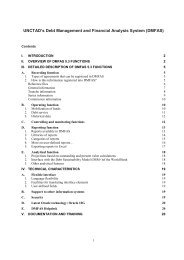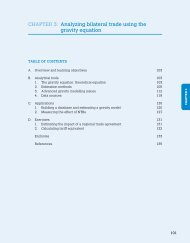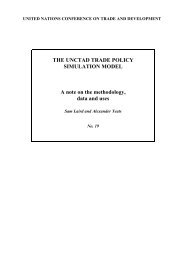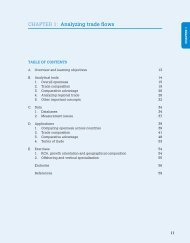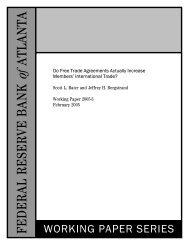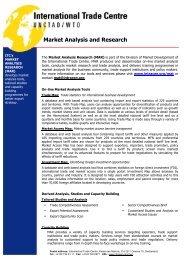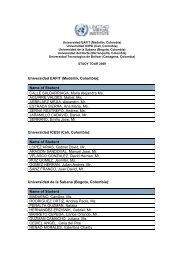WTO: World Trade Report 2010 - World Trade Organization
WTO: World Trade Report 2010 - World Trade Organization
WTO: World Trade Report 2010 - World Trade Organization
You also want an ePaper? Increase the reach of your titles
YUMPU automatically turns print PDFs into web optimized ePapers that Google loves.
world trade report <strong>2010</strong><br />
A. Introduction<br />
<strong>Trade</strong> and output growth resumed in the second half of<br />
2009 following record declines earlier in the year. The<br />
recovery through the first quarter of <strong>2010</strong> was<br />
insufficient to attain pre-crisis levels. The <strong>WTO</strong> has<br />
projected a further recovery in <strong>2010</strong> from the depressed<br />
levels of 2009, which should reverse some but not all of<br />
the impact of the trade collapse. One positive<br />
development in 2009 was the absence of any major<br />
increase in trade barriers imposed by <strong>WTO</strong> members in<br />
response to the crisis, despite high unemployment in<br />
many countries. The <strong>WTO</strong> system of trade regulation<br />
played a significant role in helping to prevent another<br />
descent into protectionism that so exacerbated<br />
economic conditions in the 1930s.<br />
The dramatic decline in world trade in 2009 (see Figure<br />
1) was even greater in US dollar terms (-22.6 per cent)<br />
than in volume terms (-12.2 per cent), thanks in large part<br />
to falling prices for oil and other primary products. 1 <strong>World</strong><br />
output as measured by gross domestic product (GDP)<br />
also fell by 2.3 per cent in 2009, the first such decline<br />
since the end of the Second <strong>World</strong> War. Taken together,<br />
these developments amounted to the most severe global<br />
economic slowdown since the Great Depression.<br />
1. Explaining the size of the trade<br />
collapse<br />
<strong>World</strong> trade volumes fell on three other occasions since<br />
1965 (-0.2 per cent in 2001, -2.0 per cent in 1982, and<br />
-7.0 per cent in 1975), but none of these episodes<br />
approached the magnitude of last year’s plunge. The<br />
slump in trade in 2009 was larger than most econometric<br />
models would have predicted given the size of the drop<br />
in GDP, and it was also larger than the decline predicted<br />
by the <strong>WTO</strong> in the early stages of the crisis.<br />
Economists have suggested a number of explanations<br />
for the trade collapse, including the imposition of some<br />
protectionist measures and reduced access to credit to<br />
finance trade transactions. However, the consensus<br />
that has emerged centres on a sharp contraction in<br />
global demand as the primary cause. 2 The weakness in<br />
demand had its roots in the sub-prime mortgage crisis<br />
in the United States, which became apparent in 2007<br />
and intensified towards the end of 2008. What began<br />
as a crisis in the US financial sector spread to the real<br />
economy, to other developed economies, and to the rest<br />
of the world in short order. The impact of the crisis on<br />
trade was further magnified by the product composition<br />
of the fall in demand, by the fact that the decline was<br />
synchronized across countries and regions, and by the<br />
growth of global supply chains in recent decades.<br />
Sharp falls in wealth linked to the recession caused<br />
households to reduce their spending on consumer<br />
durables such as automobiles (trade in automotive<br />
products was down 32 per cent in 2009), and also made<br />
firms reconsider expenditures on investment goods such<br />
as industrial machinery (down 29 per cent in 2009 – see<br />
Table 1). Purchases of these items could be postponed<br />
easily in response to heightened economic uncertainty,<br />
and they may also have been more sensitive to credit<br />
conditions than other types of goods. The reduction in<br />
demand for these products then fed through to markets<br />
that supply inputs for their production, particularly iron<br />
and steel (down 47 per cent in 2009). Shrinking demand<br />
for iron and steel was also linked to the slump in building<br />
construction in countries where property markets had<br />
been booming before the crisis. Consumer durables and<br />
capital goods make up a relatively small fraction of global<br />
GDP but a relatively large part of world trade. As a result,<br />
falling demand for these products may have had a greater<br />
impact on world trade than on world GDP.<br />
The magnitude of the trade contraction of 2009 may also<br />
have been inflated somewhat compared with earlier<br />
declines in the 1970s and ’80s due to the spread of global<br />
supply chains in the intervening years. With today’s more<br />
extensive supply chains, goods frequently cross national<br />
borders several times during the production process<br />
Figure 1: Volume of world merchandise exports, 1965-2009 (Annual percentage change)<br />
15<br />
10<br />
5<br />
0<br />
-5<br />
1965 1969 1973 1977 1981 1985 1989 1993 1997 2001 2005 2009<br />
-10<br />
-15<br />
20<br />
Source: <strong>WTO</strong> International <strong>Trade</strong> Statistics.



